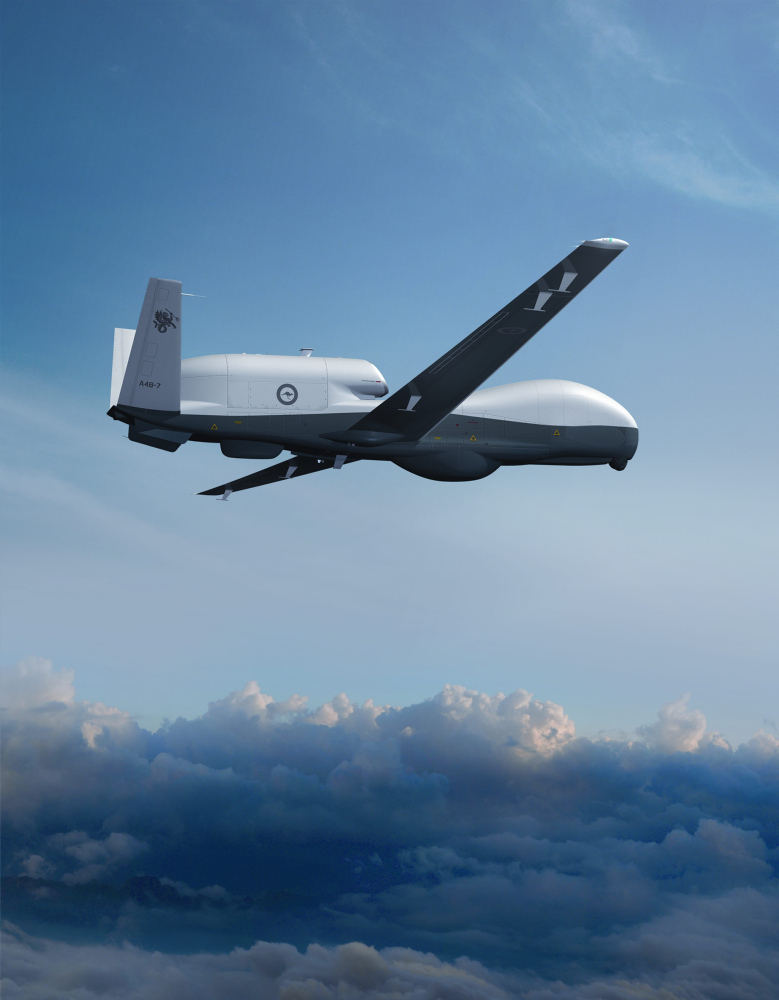Northrop Grumman Support to RAAF Tritons
Australian firms stand to gain substantial work from the Triton unmanned aircraft program as the RAAF progressively rolls out an advanced capability to conduct long-range maritime surveillance.
The first Northrop Grumman MQ-4C Triton aircraft isn’t expected to reach Australia until 2023 or later, but already local firms are looking to gain work on the program. Long-term sustainment will be all-Australian, while Australia will work with the US Navy on future development.
Northrop Grumman’s director of international programs for Triton Ed Graziano, said there was a robust plan for Australian industry involvement in production of aircraft and in their long-term support. He said some industry partnerships were already in place for the supply of components such as cables and sheet metal, which would be expanded to include electronic equipment, composites for airframe parts and sensors.
“We are working with Quickstep, QinetiQ, Daronmont, Ferra, Marand and others,” Graziano told Australian media in the US last week. “They will support not just the build-up and delivery of Australian aircraft and systems, but also US Navy systems.
“We need to ensure we have a cost-effective solution for both Australian and the US Navy,” he added. “We need to find the sweet spot where there is a technology and a capability that the (Australian) SMEs can take on to be able to provide either that work required or the sub-systems. We are going through that. “
The government finally said in a Gate 2 announcement June last year that it would acquire the first of six Tritons in a deal worth almost $7 billion including all aircraft, base infrastructure at RAAF bases Edinburgh and Tindal, and initial training, support and spares. But to-date, no contract has been signed.
And Triton has been a long time coming – the Commonwealth first disclosed an interest in a maritime HALE capability close to two decades ago. In 2001 a pre-production version of Triton’s predecessor, the Global Hawk made a non-stop record-breaking flight from Edwards AFB in California to RAAF Edinburgh. First pass (Gate 1) approval to the project was announced in March 2014.
Triton flies at altitudes above 50,000 feet and can conduct surveillance of 2.5 million square kilometres of ocean on each mission, descending to take a closer look at items of interest. The Triton fleet will be based at RAAF Edinburgh and operate in conjunction with the RAAF’s new Boeing P-8A Poseidon manned maritime ISR aircraft, and will also operate from RAAF Tindal near Katherine in the NT.
Graziano said Northrop Grumman planned to train Australian nationals to be able to support, operate and maintain the aircraft. “Once we deliver the aircraft to Australia, the sustainment starts at that point.”
There’s no mandated level of Australian industry involvement in the Triton program, but Northrop Grumman did submit an Australian industry capability (AIC) plan as part of the Gate 2 proposal process. And although Australia has announced it will buy Triton, Northrop Grumman is yet to contracted by the US Navy for long-lead items for Australian aircraft.
Australia and the US Navy have also signed a cooperative agreement for the future development of Triton, in particular the definition and development of the follow-on ‘Multi-INT’ signals intelligence payload the aircraft will employ. “We do also look at industry capability development as part of road mapping with the SMEs,” said Graziano. “We have had some dialogues with (Australia radar firm) CEA Technology…about sensor concepts and development.”
The US Navy plans to declare EOC (early operational capability) in the next few months, more than 12 months later than originally planned, and after a further slight delay following an incident in September in which one aircraft made a belly landing at the US Navy station at NAS Ventura County at Point Mugu near Los Angeles, and a subsequent temporary operational pause.
So far eight aircraft have been produced for the US Navy from a planned 68 aircraft.
This article was published by our partner Australian Defence Business Review on January 17, 2019.
File photosof MQ-4C Triton. Courtesy of Northrop Grumman.

